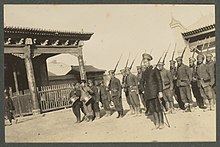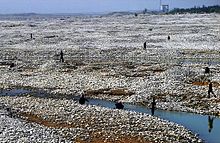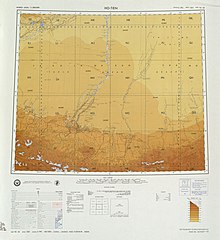
A | B | C | D | E | F | G | H | CH | I | J | K | L | M | N | O | P | Q | R | S | T | U | V | W | X | Y | Z | 0 | 1 | 2 | 3 | 4 | 5 | 6 | 7 | 8 | 9
Hotan
Khotan, Hetian, Gosthana | |
|---|---|
 | |
| Coordinates: 37°07′N 79°55′E / 37.117°N 79.917°E | |
| Country | China |
| Autonomous region | Xinjiang |
| Prefecture | Hotan |
| Municipal seat | Nurbagh Subdistrict |
| Area | |
| • Total | 465.84 km2 (179.86 sq mi) |
| Elevation | 1,382 m (4,534 ft) |
| Population (2020)[2] | |
| • Total | 501,028 |
| • Density | 1,100/km2 (2,800/sq mi) |
| Demographics | |
| • Ethnic groups |
|
| • Spoken languages | Uyghur, Mandarin Chinese |
| Time zone | UTC+8 (China Standard[a]) |
| Postal code | 839000 |
| Area code | 0903 |
| GDP (Nominal)[3] | 2018 |
| – Total | ¥8.274 billion $1.247 billion |
| – Per Capita | ¥20,399 $3,076 |
| – Growth | |
| License plate prefix | 新R |
| Website | Hotan Government Website (in Chinese) |
| Hotan | |||||||||||||||
|---|---|---|---|---|---|---|---|---|---|---|---|---|---|---|---|
| Uyghur name | |||||||||||||||
| Uyghur | خوتەن | ||||||||||||||
| |||||||||||||||
| Chinese name | |||||||||||||||
| Chinese | 和田 | ||||||||||||||
| |||||||||||||||
| Alternative Chinese name | |||||||||||||||
| Simplified Chinese | 和阗 | ||||||||||||||
| Traditional Chinese | 和闐 | ||||||||||||||
| |||||||||||||||
| Second alternative Chinese name | |||||||||||||||
| Simplified Chinese | 于窴 | ||||||||||||||
| Traditional Chinese | 于窴 | ||||||||||||||
| |||||||||||||||
Hotan or Khotan (see also § Etymology) is a major oasis town in southwestern Xinjiang, an autonomous region in Northwestern China. The city proper of Hotan broke off from the larger Hotan County to become an administrative area in its own right in August 1984. It is the seat of Hotan Prefecture.
With a population of 408,900 (2018 census),[4] Hotan is situated in the Tarim Basin some 1,500 kilometres (930 mi) southwest of the regional capital, Ürümqi. It lies just north of the Kunlun Mountains, which are crossed by the Sanju, Hindutash and Ilchi passes. The town, located southeast of Yarkant County and populated almost exclusively by Uyghurs, is a minor agricultural center. An important station on the southern branch of the historic Silk Road, Hotan has always depended on two strong rivers, the Karakash River and the White Jade River, to provide the water needed to survive on the southwestern edge of the vast Taklamakan Desert. The White Jade River still provides water and irrigation for the town and oasis.[5][6]
Etymology
Hotan (or Khotan) and its surrounding area were originally known as Godana in ancient Sanskrit cosmological texts.[7] The Chinese transcribed the name as 于窴, pronounced Gudana in Middle Chinese (Yutian in modern Standard Chinese); the pronunciation eventually morphed into Khotan. In the 7th century, the Chinese Buddhist monk and scholar Xuanzang attempted to remedy this lexical change. Xuanzang, who was well-versed in Sanskrit, proposed that the traditional name was in fact Kustana (गौस्तन) and asserted it meant "breast of the earth". However, this was likely borrowed from the Tibetan name for the region, Gosthana, which means "land of cows". It is therefore most likely that the original name of Hotan was Sanskritic in origin, a consequence of ancient Indian settlement in the region.[8][9]
An alternative etymology is proposed by Harold Walter Bailey, an expert in the Khotanese language. He believes the oldest indigenous name to be Hvatana.[10]
Hotan was known to 19th-century European explorers as Ilchi.
The official Uyghur-to-Latin transliteration, and therefore English spelling, of the modern city's name is "Hotan" according to the Register of Chinese Geographic Places.[11] The Hanyu pinyin romanization Hetian has also been used on some maps and by some airports. The city's former Chinese name was written with a different character for "tian" (simplified Chinese: 阗; traditional Chinese: 闐; pinyin: Tián).
History


The oasis of Hotan is strategically located at the junction of the southern (and most ancient) branch of the Silk Road joining China and the West with one of the main routes from ancient India and Tibet to Central Asia and distant China. It provided a convenient meeting place where not only goods, but technologies, philosophies, and religions were transmitted from one culture to another.
Tocharians lived in this region over 2000 years ago. Several of the Tarim mummies were found in the region. At Sampul, east of the city of Hotan, there is an extensive series of cemeteries scattered over an area about 1 kilometre (0.62 mi) wide and 23 km (14 mi) long. The excavated sites range from about 300 BCE to 100 CE. The excavated graves have produced a number of fabrics of felt, wool, silk and cotton and even a fine bit of tapestry, the Sampul tapestry, showing the face of Caucasoid man which was made of threads of 24 shades of color. The tapestry had been cut up and fashioned into trousers worn by one of the deceased. An Anthropological study of 56 individuals showed a primarily Caucasoid population.[12][13] A study in 2010 showed that an Eastern Eurasian lineage common in Siberia dominates the mitochondrial DNA of the mummies from the Xiaohe Cemetery. Their Y chromosome is distributed throughout Eastern Europe, South Asia, Central Asia, and Siberia.[14]
There is a relative abundance of information on Hotan readily available for study. The main historical sources are to be found in the Chinese histories (particularly detailed during the Han[15] and early Tang dynasties) when China was interested in control of the Western Regions, the accounts of several Chinese pilgrim monks,[16] a few Buddhist histories of Hotan that have survived in Classical Tibetan and a large number of documents in the Iranian Saka language and other languages discovered, for the most part, early this century at various sites in the Tarim Basin and from the hidden library at the Mogao Caves near Dunhuang.
Indo-Greek Khotan
In the Hellenistic period, there was an Indo-Greek colony in Khotan.[17]
Buddhist Khotan


The ancient Kingdom of Khotan was one of the earliest Buddhist states in the world and a cultural bridge across which Buddhist culture and learning were transmitted from India to China.[18] Its capital was located to the west of the modern city of Hotan. The inhabitants of the Kingdom of Khotan, like those of early Kashgar and Yarkant, spoke Saka, one of the Eastern Iranian languages. Khotan's indigenous dynasty (all of whose royal names are Indian in origin) governed a fervently Buddhist city-state boasting some 400 temples in the late 9th/early 10th century—four times the number recorded by Xuanzang around 630. The kingdom was independent but was intermittently under Chinese control during the Han and Tang dynasties.
After the Tang dynasty, Khotan formed an alliance with the rulers of Dunhuang. Khotan enjoyed close relations with the Buddhist centre at Dunhuang: the Khotanese royal family intermarried with Dunhuang élites, visited and patronized Dunhuang's Buddhist temple complex, and donated money to have their portraits painted on the walls of the Mogao grottos. Through the 10th century, Khotanese royal portraits were painted in association with an increasing number of deities in the caves. Besides this, a particular site, Melikawat functioned as a major Buddhist center in the Kingdom of Khotan.
In the 10th century, Khotan began a struggle with the Kara-Khanid Khanate, a Turkic state.[19] The Kara-Khanid ruler, Sultan Satuq Bughra Khan, had converted to Islam:
Satuq's son, Musa, began to put pressure on Khotan in the mid-10th century, and sometime before 1006 Yusuf Qadir Khan of Kashgar besieged and took the city. This conquest of Buddhist Khotan by the Muslim Turks—about which there are many colourful legends—marked another watershed in the Islamicisation and Turkicisation of the Tarim Basin, and an end to local autonomy of this southern Tarim city state.[20]
Some Khotanese Buddhist works were unearthed.[21][22][23]
The rulers of Khotan were aware of the menace they faced since they arranged for the Mogao grottoes to paint a growing number of divine figures along with themselves. Halfway in the 10th century Khotan came under attack by the Qarakhanid ruler Musa, and in what proved to be a pivotal moment in the Turkification and Islamification of the Tarim Basin, the Karakhanid leader Yusuf Qadir Khan conquered Khotan around 1006.[24]
Islamic Khotan
Yūsuf Qadr Khān was a brother or cousin of the Muslim ruler of Kashgar and Balasagun, Khotan lost its independence and between 1006 and 1165, became part of the Kara-Khanid Khanate. Later it fell to the Kara-Khitan Khanate, after which it was ruled by the Mongols.
When Marco Polo visited Khotan in the 13th century, he noted that the people were all Muslim. He wrote that:
Khotan was "a province eight days’ journey in extent, which is subject to the Great Khan. The inhabitants all worship Mahomet. It has cities and towns in plenty, of which the most splendid, and the capital of the province, bears the same name as that of the province…It is amply stocked with the means of life. Cotton grows here in plenty. It has vineyards, estates and orchards in plenty. The people live by trade and industry; they are not at all warlike".[25][26]
Qing period


The Qing dynasty of China conquered the Dzungar Khanate during the final stage of the Dzungar–Qing Wars in the late 1750s. By 1760, Hotan became the territory of the Qing dynasty along with the rest of Xinjiang.[27] The town suffered severely during the Dungan Revolt (1862–1877) against the Qing rule and again a few years later when Yaqub Beg of Kashgar made himself master of Kashgaria,[28][29] ruling the newly founded Turkic state known at the time as Yettishar.[30][31] However, Xinjiang was reconquered by the Qing dynasty by 1877 and was converted into a province in 1884.[27]
Post-Qing

Qing imperial authority collapsed in 1912. During the Republican era in China, warlords and local ethnic self-determination movements wrestled over control of Xinjiang. Abdullah Bughra, Nur Ahmad Jan Bughra, and Muhammad Amin Bughra declared themselves Emirs of Khotan during the Kumul Rebellion. Tunganistan was an independent administered region in the southern part of Xinjiang from 1934 to 1937. The territory included the oases of the southern Tarim Basin; the centre of the region was Khotan. Beginning with the Islamic rebellion in 1937, Hotan and the rest of the province came under the control of warlord Sheng Shicai. Sheng was later ousted by the Kuomintang.[citation needed]
People's Republic of China
Shortly after the Communists won the civil war in 1949, Hotan was incorporated into the People's Republic of China.
In 1983/4, the urban area of Hotan was administratively split from the larger Hotan County, and from then on governed as a county-level city.[1][32]
On July 11, 2006, the townships of Jiya and Yurungqash (Yulongkashi) in Lop County and Tusalla (Tushala) in Hotan County were transferred to Hotan City.[1]
Following the July 2009 Ürümqi riots, ethnic tensions rose in Xinjiang and in Hotan in particular. As a result, the city has seen occasional bouts of violence. In June 2011, Hotan opened its first passenger-train service to Kashgar, which was established as a special economic zone following the riots. In July of the same year, a bomb and knife attack occurred on the city's central thoroughfare. In June 2011, authorities in Hotan Prefecture sentenced Uyghur Muslim Hebibullah Ibrahim to ten years imprisonment for selling "illegal religious materials".[33][34] In June 2012, Tianjin Airlines Flight 7554 was hijacked en route from Hotan to Ürümqi.
In a report from the Uyghur American Association, in June 2012, notice was said to be given that police planned to undertake a search of every residence in Gujanbagh (Gujiangbage), Hotan. Hotan is the last municipality in Xinjiang with a majority Ugyhur presence in the core of the city. The UAA viewed this as an attempt to systematically intimidate the Uyghur population in Hotan.[35][better source needed]
The Sultanim Cemetery (37°07′02″N 79°56′04″E / 37.11722°N 79.93444°E) in central Hotan was a historical Uyghur graveyard that also included a religious shrine. According to a 2019 interview by the Uyghur Human Rights Project, the cemetery entombed four commanders of Sultan Satuq Bughra Khan, who conquered the city around 960 CE and spread Islam. Due to space limitations after over a thousand years of burials, multiple bodies had to reuse the same grave, and additionals layers were dug underneath old ones.[36] Between 2018 and 2019, the cemetery was demolished and the western part of the land turned into a parking lot.[37][38][39][40]
Geography and climate

Hotan has a temperate zone, cold desert climate (Köppen BWk), with a mean annual total of only 36.5 millimetres (1.44 in) of precipitation falling on 17.3 days of the year. Due to its southerly location in Xinjiang just north of the Kunlun Mountains, during winter it is one of the warmest locations in the region, with average high temperatures remaining above freezing throughout the year. The monthly 24-hour average temperature ranges from −3.9 °C (25.0 °F) in January to 25.8 °C (78.4 °F) in July, and the annual mean is 13.03 °C (55.5 °F). The diurnal temperature variation is not large for a desert, averaging 11.8 °C (21.2 °F) annually. Although no month averages less than half of possible sunshine, the city only receives 2,587 hours of bright sunshine annually, which is on the low end for Xinjiang; monthly percent possible sunshine ranges from 50% in March to 75% in October.
| Climate data for Hotan, elevation 1,375 m (4,511 ft), (1991–2020 normals) | |||||||||||||
|---|---|---|---|---|---|---|---|---|---|---|---|---|---|
| Month | Jan | Feb | Mar | Apr | May | Jun | Jul | Aug | Sep | Oct | Nov | Dec | Year |
| Record high °C (°F) | 20.5 (68.9) |
22.0 (71.6) |
30.6 (87.1) |
34.6 (94.3) |
37.6 (99.7) |
39.8 (103.6) |
41.1 (106.0) |
40.2 (104.4) |
35.9 (96.6) |
30.0 (86.0) |
24.7 (76.5) |
18.3 (64.9) |
41.1 (106.0) |
| Mean daily maximum °C (°F) | 1.2 (34.2) |
7.3 (45.1) |
16.7 (62.1) |
24.1 (75.4) |
28.1 (82.6) |
31.2 (88.2) |
32.9 (91.2) |
31.6 (88.9) |
27.6 (81.7) |
21.0 (69.8) |
12.1 (53.8) |
3.4 (38.1) |
19.8 (67.6) |
| Daily mean °C (°F) | −3.8 (25.2) |
1.9 (35.4) |
10.6 (51.1) |
17.6 (63.7) |
21.6 (70.9) |
24.8 (76.6) |
26.4 (79.5) |
25.2 (77.4) |
21.0 (69.8) |
14.0 (57.2) |
5.7 (42.3) |
−1.7 (28.9) |
13.6 (56.5) |
| Mean daily minimum °C (°F) | −7.9 (17.8) |
−2.8 (27.0) |
5.1 (41.2) |
11.8 (53.2) |
15.8 (60.4) |
19.3 (66.7) |
21.0 (69.8) |
20.0 (68.0) |
15.5 (59.9) |
8.0 (46.4) |
0.8 (33.4) |
−5.7 (21.7) |
8.4 (47.1) |
| Record low °C (°F) | −21.0 (−5.8) |
−19.3 (−2.7) |
−7.0 (19.4) |
−0.2 (31.6) |
4.3 (39.7) |
9.5 (49.1) |
12.2 (54.0) |
10.2 (50.4) |
4.3 (39.7) |
−2.1 (28.2) |
−12.3 (9.9) |
−19.3 (−2.7) |
−21.0 (−5.8) |
| Average precipitation mm (inches) | 1.9 (0.07) |
2.1 (0.08) |
3.1 (0.12) |
3.4 (0.13) |
7.3 (0.29) |
10.4 (0.41) |
6.1 (0.24) |
6.0 (0.24) |
4.5 (0.18) |
1.2 (0.05) |
1.1 (0.04) |
1.5 (0.06) |
48.6 (1.91) |
| Average precipitation days (≥ 0.1 mm) | 2.6 | 1.4 | 0.9 | 1.4 | 2.4 | 3.7 | 3.2 | 2.2 | 1.2 | 0.3 | 0.5 | 1.8 | 21.6 |
| Average snowy days | 5.0 | 2.6 | 0.6 | 0 | 0 | 0 | 0 | 0 | 0 | 0 | 0.6 | 3.8 | 12.6 |
| Average relative humidity (%) | 53 | 42 | 29 | 27 | 33 | 36 | 40 | 42 | 41 | 37 | 41 | 53 | 40 |
| Mean monthly sunshine hours | 175.4 | 176.0 | 208.5 | 225.0 | 263.8 | 263.2 | 246.0 | 231.0 | 240.4 | 267.3 | 222.4 | 183.2 | 2,702.2 |
| Percent possible sunshine | 57 | 57 | 55 | 57 | 60 | 60 | 56 | 56 | 66 | 79 | 74 | 62 | 62 |
| Source: China Meteorological Administration[41][42][43] | |||||||||||||
Administrative divisions

The city includes four subdistricts, three towns, five townships and two other areas:[1][44][45]
| Name | Simplified Chinese | Hanyu Pinyin | Uyghur (UEY) | Uyghur Latin (ULY) | Administrative division code | Notes | |
|---|---|---|---|---|---|---|---|
| Subdistricts | |||||||
| Nurbagh Subdistrict (Nurbag) |
努尔巴格街道 (奴尔巴格街道[46]) |
Nǔ'ěrbāgé Jiēdào | نۇرباغ كوچا باشقارمىسى | nurbagh kocha bashqarmisi | 653201001 | ||
| Gujanbagh Subdistrict | 古江巴格街道 | Gǔjiāngbāgé Jiēdào | گۇجانباغ كوچا باشقارمىسى | gujanbagh kocha bashqarmisi | 653201002 | ||
| Gulbagh Subdistrict | 古勒巴格街道 | Gǔlèbāgé Jiēdào | گۈلباغ كوچا باشقارمىسى | gülbagh kocha bashqarmisi | 653201003 | ||
| Narbagh Subdistrict | 纳尔巴格街道 | Nà'ěrbāgé Jiēdào | نارباغ كوچا باشقارمىسى | narbagh kocha bashqarmisi | 653201004 | ||
| Towns | |||||||
| Laskuy Town | 拉斯奎镇 | Lāsīkuí Zhèn | لاسكۇي بازىرى | laskuy baziri | 653201100 | ||
| Yurungqash Town[47] | 玉龙喀什镇 | Yùlóngkāshí Zhèn | يۇرۇڭقاش بازىرى | yurungqash baziri | 653201101 | Zdroj:https://en.wikipedia.org?pojem=Hotan||



